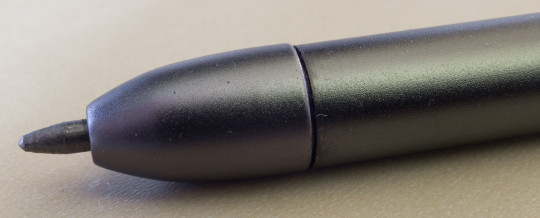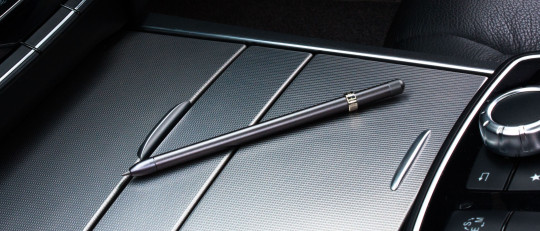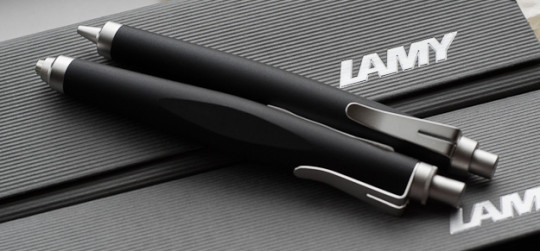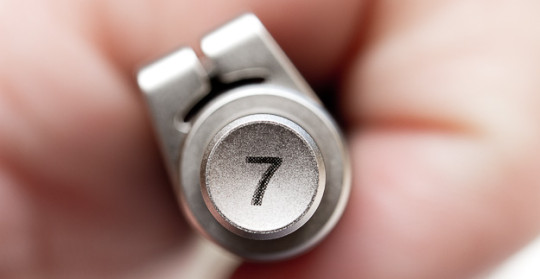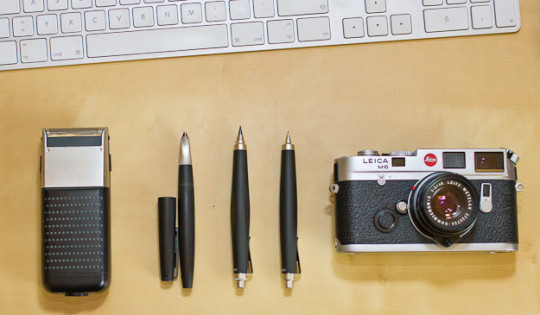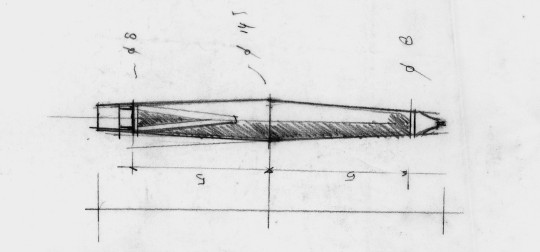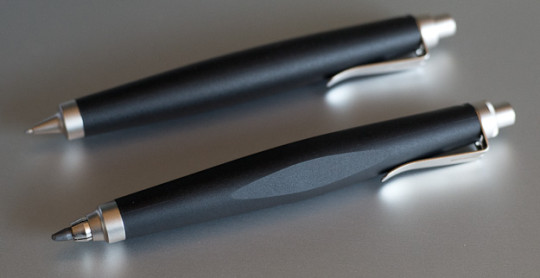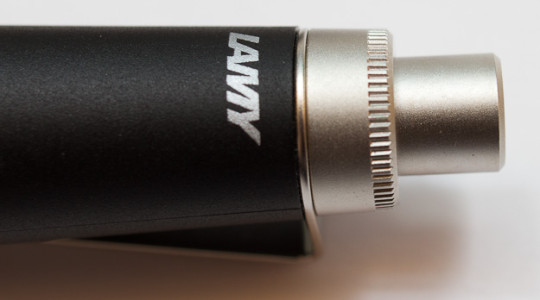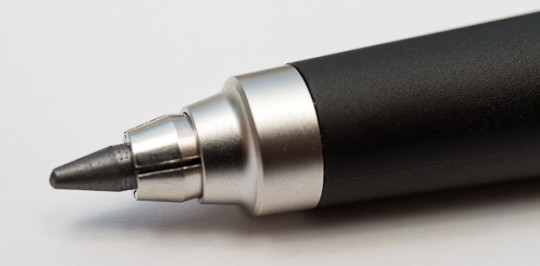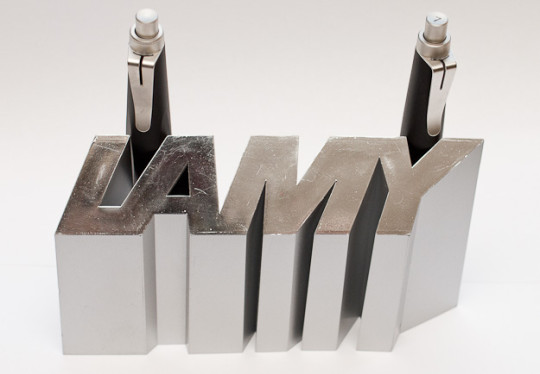Nespresso + Caran d’Ache

Thanks to Pen Heaven I was able to get my hands on a Nespresso + Caran d’Ache fixpencil for the purpose of writing a review.
Cooperations, like the one between Nespresso and Caran d’Ache, often use the letter “x” between the two company names, but Nespresso and Caran d’Ache have opted for the use of the “+” instead, so I will follow their approach.
Before the Fixpencil arrived I expected to see a lead holder that is basically the same as the standard Caran d’Ache (CdA) Fixpencil, just in a different colour, but to my surprise there were several unexpected, but noticeable, if small, differences.

First up: the pen itself.
The surface of the pen, or rather the paint, is less smooth that the other CdA Fixpencils I have handled so far. This surface is not too rough for your fingers and feels pleasant to use. The colour is imitating the aluminium look of the Nespresso coffee capsules.

My pen had three small indentation on the body that don’t seem to belong there. I assume this is a one-off quality control issue.
This Fixpencil is most likely not the only CdA made from recycled aluminium, as mentioned in my previous Nespresso bog post, so I assume the issue with the dents is not a direct result of using recycled aluminium. The dents could probably have occurred with any CdA Fixpencil or other hexagonal aluminium pen, like the 849 and I wouldn’t expect to to be common.
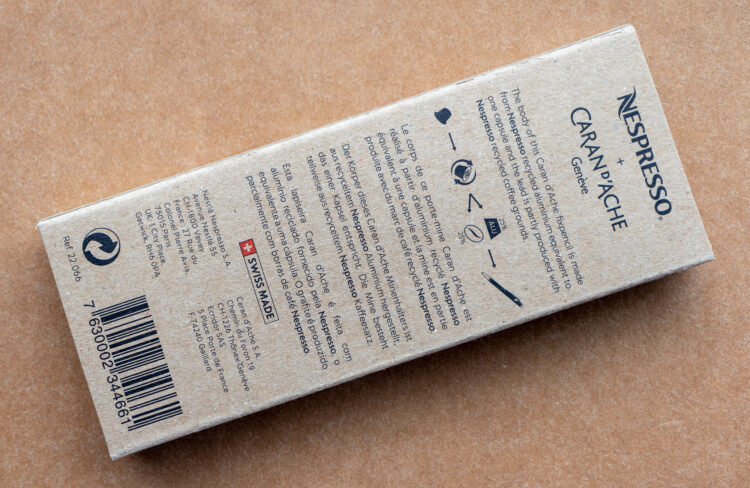
The packaging states that the pen is made from Nespresso recycled aluminium equivalent to one capsule. A very specific claim and as mentioned before I will believe this claim despite some of CdA’s previous claims that were misleading.

When I first used this lead holder I thought the pen feels lighter or ‘hollower’. After using the pen a few times I must have gotten used to it as I don’t notice this anymore, A quick trip to the scales confirmed the initial impression, though: The Fixpencil 22 and the Fixpencil 884 (Junior) both weigh 11.75g, while the Nespresso + Caran d’Ache edition weighs 11.05g.

The internal mechanism also came as a surprise. The mechanism is the same as in the currently available Fixpencil 884 (Junior). I write “currently available” as the 884 might have contained a different mechanism in the past, but I am not able to verify this.

Correction 4.6.2023: The push button of the Nespresso can actually be removed and has a sharpener built in. I am not sure why I wasn’t able to remove it originally, but now that it has been removed once it is easy to remove it again. This blog post has been updated accordingly.
Next: the lead
To me the Nespresso lead is a big let down. The packaging states that the lead is “partly produced with Nespresso recycled coffee grounds”.

Weight-wise the lead is similar to the CdA Technograph lead, but the surface looks very different: rough and matt instead of smooth and shiny.
This is an interesting idea, but unfortunately, the lead doesn’t write very well, unless you are keen on faint pencil lines. If wonder if those coffee grounds would have had a better use if they were used as fertiliser. Depending on the paper you write on this issue is more or less pronounced, but for me the Nespresso lead’s attributes are nowhere near as desirable as the Technograph’s.

The lead feels smooth on most paper, but produced a very light line on paper, much lighter than what you would get from Faber-Castell for example. I mention Faber-Castell because the lines produced by their leads are already very light compared to other, like Staedtler for example. Pressing harder when writing with the Nespresso lead won’t help with producing a darker line, i.e. the lead has a high pressure insensitivity.
When you sharpen the lead to a fine point it also seems to break easier than the Technograph lead. To some extent this behaviour reminds me of the Wopex lead, just that the Nespresso lead provides a much worse writing experience. I haven’t had a chance yet to use the Nespresso wood-cased pencil and I doubt I will find someone IRL who owns some and let me try, but based on Pencil Talk’s review of the Nespresso Swiss Wood Pencils, which doesn’t mention the issues I encountered, I wonder if the lead in the Nespresso Fixpencil is worse than the one from the Nespresso pencils.
A side point, but just in case you wonder: the Nespresso lead weighs the same as the Technograph lead.

Overall, this is a nice lead holder with a good, sturdy build. It would have been nice if this Fixpencil came with the same mechanism as the Fixpencil 22. The higher price than normal Fixpencil is due to the fact that this is a Limited Edition – funnily enough that links strongly to Kiwi-D’s and Koralatov’s comments on my previous blog post.
You can find another review of this pencil at The Gentleman Stationer.
Nespresso + Caran d’Ache Read More »













